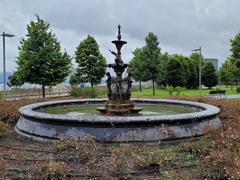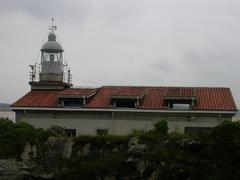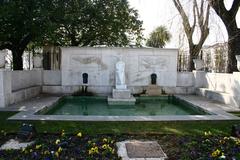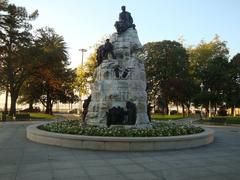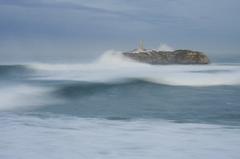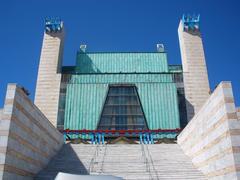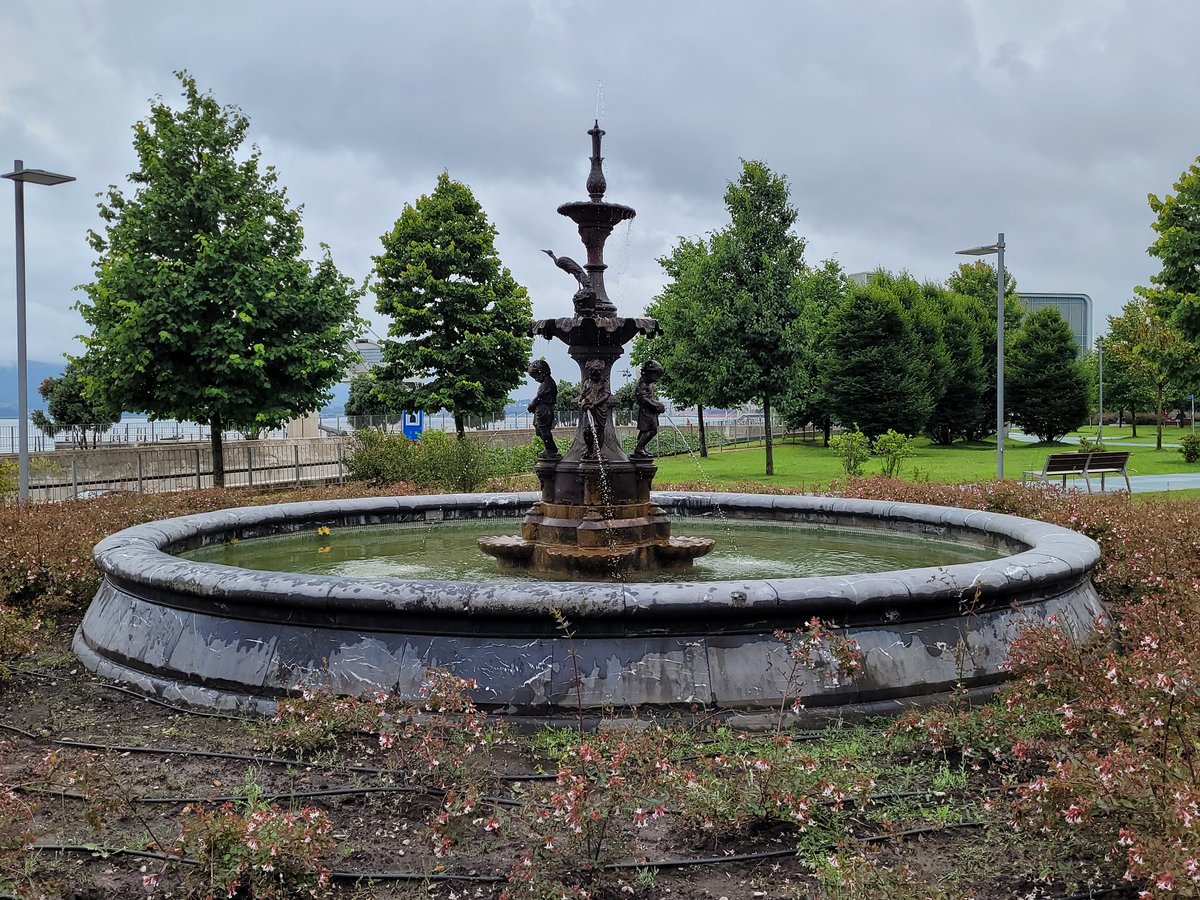
Fuente De Los Meones: Visiting Hours, Tickets, and Travel Guide – Santander, Spain
Date: 14/06/2025
Introduction
Fuente De Los Meones, a beloved historic fountain nestled in the heart of Santander, Spain, is much more than a picturesque landmark. Adorned with playful bronze children and intricate stonework, the fountain reflects the city’s rich industrial and maritime heritage, artistic traditions, and communal spirit. Open to the public year-round and always free to enjoy, Fuente De Los Meones invites visitors to engage with Santander’s past and present in a space that is both welcoming and emblematic of the city’s enduring relationship with water and public art (GoAskALocal, Santander Turismo, Piezas Fundidas Made in Cantabria).
Table of Contents
- Introduction
- History and Urban Development
- Role of Water and Public Fountains in Santander
- Industrial Heritage and the Fountain’s Social Significance
- The Impact of the 1941 Fire and Urban Renewal
- Preservation and Contemporary Importance
- Artistic and Architectural Features
- Visitor Information: Hours, Tickets, Accessibility
- Nearby Attractions and Suggested Itineraries
- Visitor Experience and Practical Tips
- Special Events, Tours, and FAQs
- Summary and Recommendations
- References
History and Urban Development
From Roman Port to Modern City
Santander’s development began with its strategic location as a Roman port on the Bay of Biscay. Over centuries, this advantageous position fostered growth as a maritime and commercial hub. By the 19th century, industrialization and population booms prompted the construction of new neighborhoods and essential infrastructure, including public fountains such as Fuente De Los Meones (GoAskALocal).
The Role of Water and Public Fountains
Water access has always been central to urban life in Santander. Public fountains were vital for providing clean drinking water, supporting sanitation, and serving as communal gathering places. The city’s expansion in the industrial era made these fountains crucial for both practical needs and social interaction (Cantabria24Horas).
Industrial Heritage and the Fountain’s Social Significance
During Santander’s industrial rise, fueled by maritime trade and the arrival of railways, public fountains were symbols of modernization and social welfare. Fuente De Los Meones, in particular, served as a hub for workers and families in the rapidly growing city. Its enduring presence speaks to the importance of such landmarks in shaping community identity and supporting daily life (GoAskALocal).
The Impact of the 1941 Fire and Urban Renewal
The catastrophic fire of 1941 devastated much of Santander’s city center, leading to substantial urban renewal. Some historical fountains disappeared, but Fuente De Los Meones survived or was restored, blending traditional aesthetics with modern infrastructure and remaining a cherished city landmark (The Common Wanderer).
Preservation and Contemporary Importance
Today, Fuente De Los Meones stands as a living testament to Santander’s layered history. Preservation efforts by local authorities and cultural organizations ensure that the fountain remains safe, accessible, and relevant, even as the surrounding cityscape evolves (Cantabria24Horas, Santander City Council).
Artistic and Architectural Features
Design and Symbolism
Fuente De Los Meones is celebrated for its playful bronze children, each holding a jug—an artistic nod to European traditions like Brussels’ Manneken Pis. The fountain’s multi-tiered design includes sculpted animals and ornate crowns, blending neoclassical and Rococo influences to create a harmonious centerpiece in its urban setting (Santander Turismo, Piezas Fundidas Made in Cantabria).
Construction and Restoration
The fountain was originally donated by the López-Dóriga family, prominent industrialists, and crafted in the Dóriga foundries of San Martín. Recent restoration projects have focused on cleaning the bronze, repairing stonework, and upgrading water systems, ensuring the site’s longevity and compliance with environmental standards (Santander City Council).
Integration with the City
Located in the Jardines de Pereda, near the bustling Paseo de Pereda, the fountain is surrounded by elegant 19th-century architecture and public gardens. Its placement encourages relaxation, socializing, and appreciation of Santander’s urban landscape (Turismo de Santander).
Visitor Information
Location and Access
- Address: Jardines de Pereda, Santander, Cantabria, Spain
- How to Get There: Easily accessible on foot from the city center, or via bus, train, taxi, and bicycle. Public transport stops are located along Paseo de Pereda. Santander’s main train and bus stations are within a 10–15 minute walk (Piezas Fundidas Made in Cantabria).
- Parking: Underground parking is available beneath the Jardines de Pereda, with additional spaces nearby.
Visiting Hours and Tickets
- Hours: Open 24/7, year-round.
- Admission: Free; no tickets required for visiting the fountain or gardens.
Accessibility
- Physical Access: The gardens and fountain are flat, paved, and wheelchair/stroller accessible.
- Signage: Bilingual information is available, though detailed historical plaques are limited.
- Facilities: Public restrooms, benches, and shaded seating are available in the gardens (Santander Accessibility Initiatives).
Nearby Attractions and Suggested Itineraries
- Jardines de Pereda: Relax beneath mature trees, enjoy flowerbeds and sculptures, or have a picnic.
- Paseo de Pereda: Lined with elegant buildings, shops, and cafés—perfect for a scenic stroll.
- Palacete del Embarcadero: Exhibition space hosting contemporary art and cultural events.
- Centro Botín: A striking modern art center with exhibitions, concerts, workshops, and panoramic bay views (Continent Hop).
- Santander Cathedral: A short walk away, this 13th-century landmark houses the oldest monument in the city (Rough Guides).
- City Beaches: Playa de los Peligros and El Sardinero are easily accessible for those seeking seaside relaxation.
Suggested Day Trips:
- Santillana del Mar: Renowned medieval village and gateway to the Altamira Cave.
- Picos de Europa: Dramatic mountain landscapes for hiking and exploration.
- Potes: Picturesque town in the Liébana region, famous for local cuisine.
Visitor Experience and Practical Tips
- Best Time to Visit: Spring and summer (May–September) for pleasant weather, festivals, and blooming gardens. Early morning or late afternoon for optimal photography and fewer crowds.
- Atmosphere: The sound of water, lively street performers, and relaxing garden ambiance create an inviting setting for reflection and people-watching.
- Photography: The fountain’s ornate details and garden backdrop are ideal for photos, especially with soft morning or evening light.
- Safety: The area is considered very safe, with visible security and well-maintained facilities (Santander Safety Measures).
- Etiquette: Do not climb or touch the fountain. Dispose of litter responsibly.
Special Events, Tours, and FAQs
Guided Tours and Events
- Guided Walking Tours: Offered by local operators and the Santander Tourism Office, often including the fountain and other historical sites. Book in advance, especially during festivals or peak seasons.
- Festivals: The fountain and gardens come alive during local celebrations, such as Semana Grande and the Festival Internacional de Santander.
Frequently Asked Questions
Q: What are the visiting hours for Fuente De Los Meones?
A: The fountain and surrounding gardens are open 24/7.
Q: Is there an admission fee?
A: No, both the fountain and Jardines de Pereda are free to access.
Q: Is the fountain operational?
A: The fountain is sometimes switched off due to maintenance or vandalism, but its artistic value remains.
Q: How do I reach the fountain?
A: By foot, public bus, taxi, bicycle, or car (with underground parking nearby).
Q: Is the site accessible for those with reduced mobility?
A: Yes, paved paths and flat terrain make the area accessible.
Q: Are guided tours available?
A: Yes, check with the tourist office or local operators for current offerings.
Summary and Recommendations
Fuente De Los Meones stands as a vibrant symbol of Santander’s heritage—blending historical significance, playful artistry, and community value. Its central location, free admission, and accessibility make it a must-see, whether you are interested in history, art, or simply enjoying the city’s atmosphere. Combine your visit with nearby attractions like Centro Botín, Santander Cathedral, and the city’s beaches for a comprehensive Santander experience.
For the best insights, consider joining a guided tour or downloading the Audiala app for audio guides. Share your visit on social media using #FuenteDeLosMeones, and help preserve this landmark by respecting posted guidelines.
References and Further Reading
- GoAskALocal – Travel Guide to Santander Spain
- Santander Turismo – Official Tourism Website
- Piezas Fundidas Made in Cantabria – Fuente De Los Meones Santander
- Cantabria24Horas – Fuentes Patrimonio y Agua
- The Common Wanderer – Visit Santander Spain 48 Hour Travel Guide
- Santander City Council – Official Website
- Santander Environmental Report – Conservation Initiatives
- Continent Hop – Visit Santander Spain Travel Guide
- Rough Guides – Santander Travel Guide
